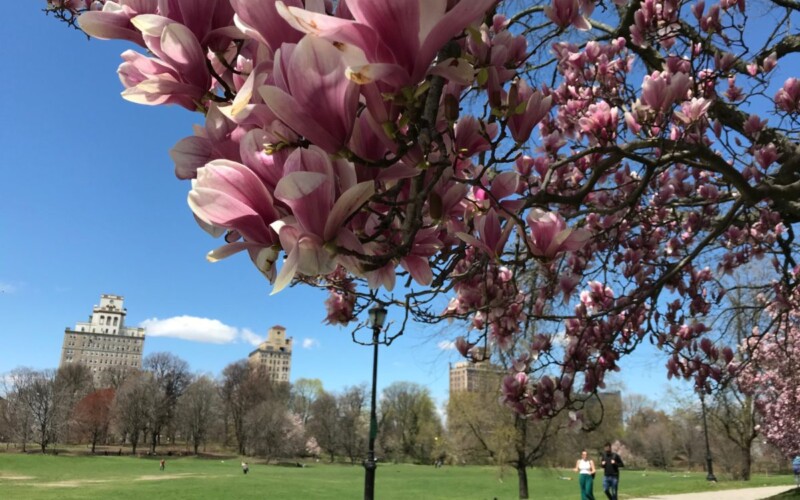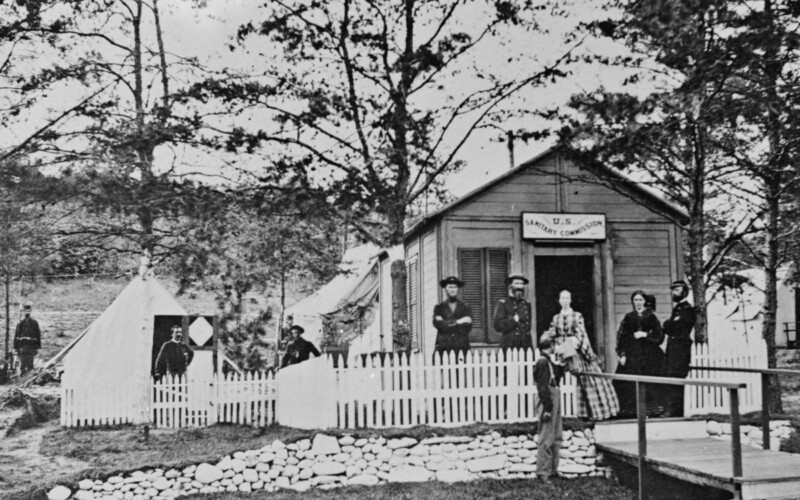On the last sunny weekend in September, I had the privilege of attending a conference filled with people passionate about landscapes. The Olmsted Network is a national organization using advocacy, education, and stewardship to champion parks across the country with connections to Frederick Law Olmsted and the firm he founded with his sons, F.L.O., Jr. and John Charles. Their weekend-long conference, this year themed “Landscapes of Renewal,” was held in Newburgh and Poughkeepsie, NY. Topics covered included the renewal and activation of parks, as well as an investigation into the advancement of health, inclusivity, and equity in the built environment. While thrilled about the itinerary, I was perhaps most excited to witness the Hudson Valley’s seasons change and visit my alma mater Vassar College, one of the hosts of the conference.

Stewarding History
The weekend began on Friday night with a screening of Laurence Cotton’s film on Olmsted Parks, Frederick Law Olmsted: Designing America. My participation began Saturday morning at the Calvary Church in Newburgh, a fitting structure to start our weekend of worship. After a moving introduction and keynote by Frank Kowsky, esteemed expert on our favorite landscape architects, Olmsted’s disciples were treated to a performance by Gail Archer on a recently-restored and still-operating Skinner organ. We sat in the wooden pews, reflecting indoors, eager to explore Downing Park.
The park was still green, with a pond the locals affectionately refer to as “polly,” after the pollywogs. Wide pathways snaked around the 35 acres, leading eventually up an incline to an overlook that framed the Hudson, the highlands, and the bustling city below. The space was designed by the fathers of American landscape architecture: Frederick Law Olmsted and Calvert Vaux; built in honor of the grandfather, of sorts, of American landscape architecture: Andrew Jackson Downing; and completed by the sons of the fathers of American landscape architecture: John Charles Olmsted and Downing Vaux.
Before stepping outside, Sarah Zewde, Assistant Professor of Practice at Harvard University Graduate School of Design and Harlem-based leader in landscape architecture today, spoke on Olmsted’s Cotton Kingdom. She reminded her audience how Olmsted advocated for “Fair Play for the Negro” and was openly frustrated by the location selected for Central Park, which dispossessed thousands of free Black residents of Seneca Village. This brought up the propensity for park development, although seemingly benevolent, to be used as a tool for the displacement of people and the obscuring of histories Olmsted hoped to save.
The question arose: how can tools of landscape architecture give rise to conversations of history and hold true to the role of public space?

Loving Landscapes
This question permeated throughout the weekend. In the event’s first panel, the Olmsted enthusiasts looked to Morgan Monaco, President of Prospect Park Alliance, for an answer. Monaco broke down the Alliance’s approach to park renewal in three parts: Restoration, Management, and Community Engagement. This final aspect of community engagement is crucial to the park’s prosperity. As Jane Jacobs observed, it is the people who make the park. People won’t defend what they don’t love, and they can’t love what they don’t know. Olmsted envisioned a park that would be taken care of in perpetuity by the city. As New York City hasn’t actualized this vision, Tupper Thomas was charged to create the Alliance, a partnership between the city and private funders to keep the park alive. Our work as Turnstile, as stewards of Prospect Park today, is to help guests build a relationship with these natural assets and facilitate a love story between people and their park to ensure stewardship when the city won’t.
Sunday, we brought our worship to Vassar’s campus in Poughkeepsie. Walking the grounds designed by John C. Olmsted—F.L.O.’s adopted son and biological nephew—my former art history professor, Yvonne Elet, talked of the “extinction of experience.” Students were hungry to get their hands dirty, she and her colleague asserted, and they were dying to step outside of the classroom and pull roots from the earth. I reflected on the landscaping of Prospect Park, accomplished by a couple hundred people using brute force to yank out trees, before inventing the “tree-moving machine.”
I thought about the resilience of the Lenape, upon whose land Prospect Park rests, and the reimagining of the Lefferts House to examine the experience of enslaved people and their relationship with agriculture. I admired the rolling landscape (a Level II Arboretum) in front of me, the same one that lured me to leave California for New York a decade ago. I remembered my final and favorite Vassar course, Contemplation in the American Landscape, taught by the poet Paul Kane. Our syllabus included a study of poetry, paintings, and meditative practices. Students of all disciplines came together to read and admire the work of Hudson River School artists while venturing to the locations which inspired these works. Indeed, it was this class that solidified my interest in landscape design and its ability to influence one’s experience.

Healthful and Healthy Parks
The final panel of the weekend investigated this influence further. The panel featured healthcare professionals and natural scientists who went beyond the sensory understandings we have of our parks and assessed them at a clinical level. “If nature were a pill, we’d all be taking it,” asserted Dr. Howard Frumkin, Senior Vice President for Trust for Public Land. He cited the mechanisms and pathways in which parks are good for the public, including their enabling of contact with nature, physical activity, and social connectivity. The role of parks in public health has become a major point of emphasis in our own backyard, Prospect Park, under Monaco’s leadership.
Of course, not all public parks have the capacity to fulfill these needs. Many parks are neglected and rely on the donations of surrounding neighborhoods (or the formation of an Alliance). As a result, we see a correlation between health inequity and park inequity. To address these concerns, Dr. Frumkin suggested urging local hospitals to consider parks in their Community Health Needs Assessment (CHNA). There is, indeed, a nature deficit, and hospitals have the potential to help overcome this lack and provide resources for communities to flourish.
As we consider the legacy of our landscapes, we must ensure their fortitude for generations to come. To live sustainably is to ensure our actions today do not compromise the ability of current and future generations to have their needs met. Olmsted imagined a community in which the city would support the parks in perpetuity. Yet New York City’s parks receive less than 1% of the city’s $100 billion budget, and recent budget cuts have carried with them serious consequences.
Instead, we may hope our healthcare providers serve our community by supporting our parks. Beyond this, we must rely on each other. Susan Masino, Professor of Applied Science at Trinity College and speaker on our final panel said, “Awe produces empathy,” So, let us move forward determined to set the scene like the Hudson River School artists who came before us, and accompany our friends and loved ones into a landscape designed to foster curiosity and camaraderie. Let us ooh and ahh at the myriad of parks on the Olmsted Trail, and take responsibility for telling histories erased and exposed by landscapes.





